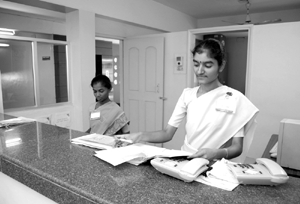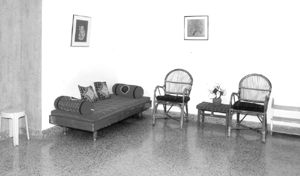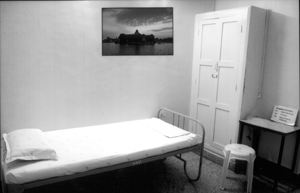Orientation to In-Patient Services
Ward is considered to be the central hub of a hospital. It is the only place where patients are with the hospital staff for a long duration and this necessitates rendering patient care at high standards so that patient satisfaction can be arrived at. This, as a result, will end up serving as a bridge between hospital and community in creating awareness.
Many of the ophthalmic surgeries are done on a day care basis in the recent days.. Still, in some countries where patients come from distant places seek admission for a day or two. Patients with systemic problems are also hospitalized for eye surgeries. So, OAs are to be familiar with ward procedures.
Preoperative and postoperative care is a critical component of nursing and preoperative care determines the patient's state of mind before surgery and attitude towards the hospital. OAs in the wards are responsible for ensuring continuity of ophthalmic care before and after surgery, and for providing physical and psychological support to patients during their stay.
In each ward, there is a nursing unit to take care of the patients for 24 hours. The OAs are fully in charge of the patients from the time they are admitted until they are discharged. Basic nursing care consists of helping the patient to carry out those health maintaining functions which he is unable to provide for himself.
The majority of ophthalmic patients are able to look after their own personal hygiene. However, occasionally a patient may become ill while in the hospital and require basic nursing care.
Differences between Eye Ward and General Ward
The Ophthalmic ward is different from the general hospital ward or a multi specialty ward. General emergencies occur less often in the ophthalmic ward. The infection rate is very minimal compared to multi specialty ward, except for cases with ocular and orbital infections which will be isolated from the other wards. Hence, the nasocomial infections will be lessened.
The OA will be able to manage normal situations and seek the advice of physician / ophthalmologist for high risk and ocular emergencies.
The patient will be able to manage themselves for a day or two after surgery in the ophthalmic ward and hence the number of attendants / visitors will be less than in the multi specialty ward. The stay of patients in the ophthalmic ward will be shorter than that of the multi specialty ward.
Skills of ophthalmic assistants in the wards
The OA in the wards requires compassionate and thoughtful care for patients, and accuracy of judgment and manual dexterity when treating the eye.
Ward OA also requires
- Experience in preoperative preparation (dispensing medications, liaison with general physician in case of systemic disorders)
- Experience in postoperative care (dispensing medications, application of dressings, examination for postoperative complications)
- Ability to identify postoperative complications early and notify the attending doctor.
- Ability to identify general emergencies and assist in crisis.
- Pre and post operative counselling skills
- Knowledge of safe administration of medication
- Understanding of aseptic technique
- Skill in bed making
- Understanding how to care for the visually impaired
- Communication skills
Location and Working Environment in Ward
Inpatient ward should be away from the out-patient department. The ward can have a different entry so that it will be easy for the patients and their visitors to move around. At the entrance of the hospital i.e. near the admission and discharge counter, the stairs and elevators should be located which will provide the path to the wards. It should be easy to identify the ward and accessible to patients. At the entrance of the ward the OAs should be allotted space to keep a computer, telephone, other necessary materials, and a wash basin to wash their hands thoroughly. This is called nurses' station. (Fig. 7.1) Opposite to this, there is the examination room with a slit lamp. In this room the ophthalmologist checks the patients before and after surgery.

The OA keeps all the necessary equipment and materials in this room. As the patients enter the ward they are to be received by the OA in the nursing station and after necessary registration, they are guided to the room allotted to them. Near the nursing station a notice board is kept which displays the following details.
Total number of beds available in each type of room
Number of beds occupied
Name of the duty doctor
Knowledge of Ward setup
- Department Structure
- Duty Doctors

Classification of rooms
- The rooms can be classified depending on the hospital structure and facilities. For example,
- Luxury room - large A/C room with facilities for attendant (Fig. 7.3).
- Private with attached bathroom (Fig. 7.3a)
- Private with shared bathrooms (Fig. 7.3b)
- General ward (Fig. 7.3c)
- Free ward and also by classification of cases :
- Clear cases
- Septic cases




Admission procedure
When the patient is ready to undergo surgery, the patient is counselled in the respective clinics or in the general counselling department.
The patient gives consent for surgery at the time of admission. The inpatient record, continuation sheet and operation notes are attached to the patient's case sheet. The patient is assigned a room at the admission counter.
The patients are sent to the respective ward duty room along with their case sheets.
- In the ward, the OA enters the details of patient in the admission register and give the patient the assigned room key. The OA guides the patient to the room.
- The patient is given a medical prescription and is sent for other required tests or procedures, according to the type of surgery.
- Instructions for taking medicine are given by the ward OA.
- Preoperative counselling is done on the day before the surgery.
- After surgery, the ward OA visits every postoperative patient, gives instructions, and answers any questions.
- The ward counsellor or the OA in the respective floor provides postoperative counselling.
Instruments and Equipment
The quality and efficiency of medical services provided in any hospital depend on the proper functioning of the equipment and instruments used by the doctors and other clinical staff. Even under normal and careful use, instruments may fail to function properly. The frequency of such failures can be considerably reduced by proper care, maintenance and timely repair.
In ophthalmology there has been a major increase in the use of sophisticated instruments and equipment during the last decade. This has led to a higher quality of eye care services and better patient satisfaction.
Ward instruments and equipment
Instrument
| S.No. | Particulars |
| 1. | Dressing trolley |
| 2. | Dressing bin (large - stainless steel) is used to keep sterile dressing |
| 3. | Dressing box |
| 4. | Medicine tray |
| 5. | Kidney tray (steel and plastic)for irrigating the eye |
| 6. | Eye lash cutting tray |
| 7. | Aluminium tray (for urine examination) |
| 8. | Scissors |
| 9. | Scissors Box (small) |
| 10. | Artery clamp |
| 11. | Cidex box |
| 12. | Saline box |
| 13. | Bandage box |
| 14. | Chitles forceps-to carry sterile items |
| 15. | Suture removal forceps-to remove the sutures |
| 16. | Lid retractor-to retract the lid for examination of the eye in oedematous lids |
| 17. | Drop opener | 18. | Urinal can |
| 19. | Bed pan |
| 20. | Silver basin with cover |
| 21. | Hot water drum |
| 22. | Tray for placing case sheets furniture |
Furniture
| S.No. | Particulars |
| 1. | Wheelchair |
| 2. | Computer table |
| 3. | Steel cupboard |
| 4. | Chairs |
| 5. | Foot stool |
| 6. | Waste bucket |
| 7. | Examination table |
| 8. | Cot |
Linen
| S.No | Particulars |
| 1. | Mattress |
| 2. | Mat |
| 3. | Pillow |
| 4. | Pillow cover |
| 5. | Bed sheet |
| 6. | Hand towel |
| 7. | Table cloth |
Equipment
| S.no | Particulars | 1. | Blood pressure apparatus- to measure the blood pressure of the patient |
| 2. | Stethescope |
| 3. | Ophthalmoscope-for fundus examination |
| 4. | Tonometer-to measure intraocular pressure |
| 5. | Gonioscope-to examine the angle |
| 6. | Slit lamp with cover-for anterior segment examination |
| 7. | Oxygen cylinder with cover |
| 8. | Torch |
| 9. | Saline stand |
Summary
A ward is that area of the hospital where all the amenities - physical, social and especially medical care - are made available to help the patients feel at home until they are discharged. It must be isolated from all OP units. The cleanliness and housekeeping of the ward are most important to avoid nasocomial infections.
The patient must be informed of all the facilities of the hospital so that they can choose as per their financial status. The equipment and instruments must be maintained properly and sterilized to avoid infections.
Key points to remember
- Handle the instruments carefully
- Patients with infection should be isolated
- Clear communication should be given to patients
- All the facilities of the hospital must be clearly explained to the patient
Student exercise
Fill in the blanks
- _______ is used to clean the eye with an antiseptic.
- _______ is used for fundus examination.
- To irrigate the eye _________ is used.
- Gauze and pads are kept in ___________.
- Patients with ___________ should be isolated.
Answer the following
- Write a paragraph about the ward orientation.
- Mention the details displayed on the ward notice board and their importance.
- Draw the ward flow chart.
- Discuss the differences between the eye ward and general ward.
- Show the equipment to each other. Identify them and state their use.
